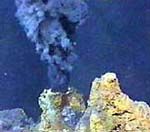Life: Extreme Forms of Life

In the search for habitable planets and moons beyond our own, scientists focus on a "Goldilocks" zone, not too close to, not too far from, the parent star; but like Earth, at just the optimal distance. As it happens, since the 1970s, discoveries of life forms in extreme environments here on our own planet suggest that life may abound elsewhere in the universe, except in permanently arid conditions.
Most of Earth life is microbial and most of it is underground or under water in conditions generally considered antagonistic to life: extremes of temperature, moisture, altitude or depth,toxicity,pressure, acidity or alkalinity. And while the term extremophile conjures up exceptional creatures thriving in unimaginable circumstances, what appears extreme to us may well be the norm.
Extreme microbes. Years ago, the well known geologist Thomas Gold predicted that microorganisms were abundant in extremely hot and toxic regions deep in the Earth's crust, and he argued that they would prove to be an ancient source of hydrocarbon deposits. Subsequently, it was discovered that vast colonies of microbes thrive on radioactive rock more than a mile below the surface. Other strange microbes thrive in the extreme conditions of deep sea hydrovents that form along tectonic plates. The hydrovents spew superheated toxic gases from the Earth's interior into the dark and freezing ocean. The depths of 4000 meters (more than 2 miles) and vent temperatures of 150 degrees C (about 300 F) would seem to preclude even the most primitive forms of life. But the microbes that colonize the hydrovents are robust creatures that feed on hydrogen produced by chemical reactions in the vents and do not require UV light or oxygen. Most belong to the domain archaea (rather than bacteria), so when they were first discovered it was assumed that archaea were associated only with extreme environments. But it turns out that although so far archaea are found to dominate in these extremes, bacteria are also found there.
Under glaciers. Single-cell extremophiles have also been found in super-cold conditions. In 2009 a group of scientists described their retrieval and revival of exceptionally small, dormant microbes from deep under an Antarctic glacier. The microbes were more than 100,000 years old. Certain types of algae thrive in snow and ice and are easily observed. These organisms are of interest for scientists who are trying to predict potential life elsewhere in the universe. The field of astrobiology is growing rapidly.
Extreme multicellular forms. Hydrovent life is not limited to microorganisms. The vents host amazing ecosystems that include unique worm-like creatures, one of which lacks organs and depends entirely on symbiont microbes attached to the worms, that carry out the metabolism functions. There are also crustaceans ranging from the very tiny to the very large. Hydrovent extremophiles are very resilient. When undersea volcanoes destroy their habitats, survivors migrate to new ones. These organisms also start new colonies by dispersing their larva on the very slow currents.
Some organisms that survive in extreme conditions are not true extremophiles. A favorite example is the tiny eight-legged Tardigrade, popularly known as the "water bear." The Tardigrade is able to survive extraordinary temperatures and conditions in water, on land, and even space. It can maintain a state of suspended animation for at least a decade. But because it has not adapted to a particular environment (e.g. hydrothermal vents), it is not classified as an extremophile. Experiments have demonstrated the remarkable ability of tardigrades to withstand the conditions of space, including radiation. These findings are described in this Scientific American article, The Smallest Astronauts, which includes splendid photos.
Ubiquitous life. With the expectation that we will discover life elsewhere in our galaxy, scientists are prospecting in all sorts of hostile environments here on Earth. They are finding it everywhere: in methane-rich lakes and sulfurous caves, glaciers at the top of the highest mountains, in arid deserts with minimal moisture, in ancient mud sediments, salt deposits, subglacial ice, and radioactive rocks. Extreme microbes have been in Antarctic and the Arctic, and in almost any other place on the planet except for the very few permanently dry areas which are completely sterile. And they survive almost anything; one group revived after thousands of years of frozen underground. The chemical requirements for the initial formation of polymers necessary for life --proteins, nucleic acid, polysaccharides--might be quite limited. But the life form, after reaching stability, might prove very adaptable.
